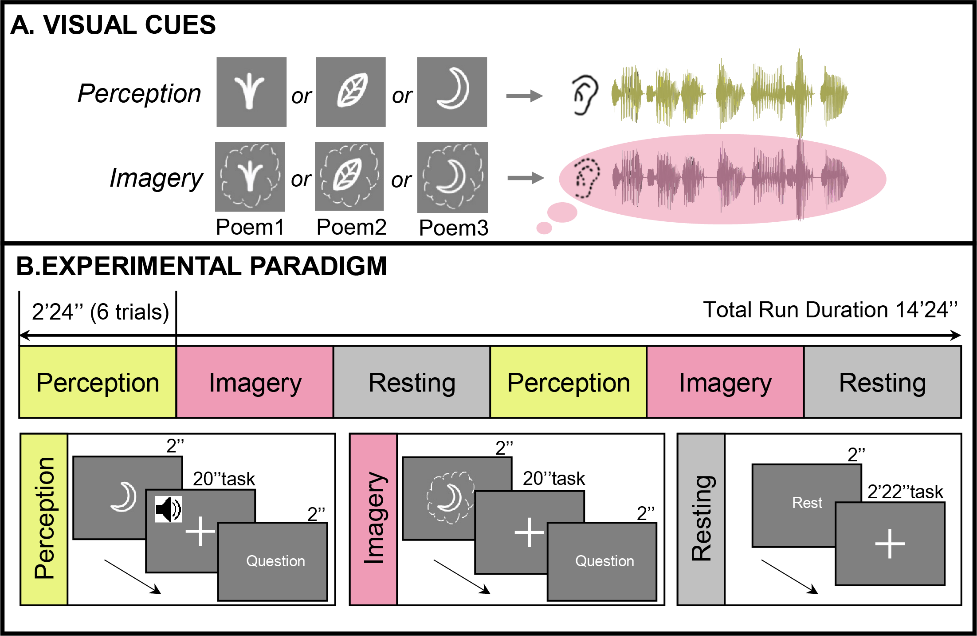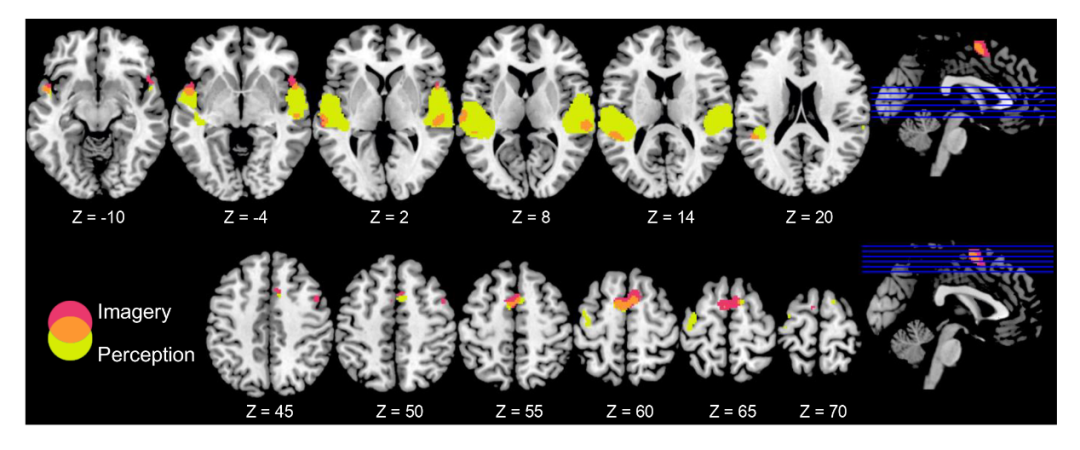With the absence of external stimuli, people can actively imagine words in their brains, for example, they can recite poems silently in their brains, and this vivid internal experience is called speech imagery. So, how does the brain produce speech imagery? What is the relationship between the neural processing of imagined speech and speech perception? These questions are not yet clear.
In December 2022, Cerebral Cortex, a neuroscience journal, published online the research paper "Common and distinct neural representations of imagined and perceived speech" by Associate Researche Lingxi Lu and Professor Gao Jiahong from the Center for Magnetic Resonance Imaging Research, Beijing Language and Culture University. The research paper, "Common and distinct neural representations of imagined and perceived speech", reveals the neural mechanisms of verbal imagery.
In this study, 30 native Chinese subjects were recruited and instructed to perform tasks of imagining ancient poems (verbal imagery condition) and listening to ancient poems (speech perception condition), and brain activity was recorded using fMRI techniques (Figure 1). Verbal imagery is usually subdivided into two processes: imagining "listening" and imagining "speaking", and in order to make a direct comparison with the perceptual process of actually hearing verbal stimuli, the experimental instructions asked the subjects to perform the imaginary "listening" task. In order to make a direct comparison with the perceptual process of hearing speech stimuli, the participants were asked to imagine "listening" to the male voice in the speech perception condition. The verbal material was an old Chinese poem in five lines.

Figure 1, A: Three different ancient poems were actually heard or imagined to be heard through visual cues. B: The experiment was conducted with a total of six consecutive scans in three conditions: verbal imagery, verbal perception, and resting state.
It was found that parts of the bilateral superior temporal gyrus (STG) and the supplementary motor area (SMA) were activated when subjects imagined hearing the ancient poems and when they actually heard them. During the internal construction of continuous speech, secondary auditory cortical areas were activated in a "top-down" manner in the brain, even when no real auditory stimuli were present. In addition, Broca's area in the left superior frontal gyrus (IFG) was significantly activated in the imagery-perception contrast, suggesting that motor language areas are involved in speech imagery even when imagining "hearing" speech rather than "speaking" it. There is also a potential correlation between the activation of IFG and STG and subjects' self-reported vividness of imagery. This research provides important empirical evidence for the neural mechanisms of verbal imagery, using continuous speech (Chinese poetry) that is more closely related to everyday life.

Figure 3, Similarities and differences in brain activation between verbal imagery and verbal perception.
The first author of the paper is Associate Researcher Lingxi Lu at Center for the Cognitive Science of Language of Beijing Language and Culture University, and the corresponding author is Professor Jiahong Gao at the Magnetic Resonance Imaging Research Center of Peking University. Meizhen Han, Guangyuan Zou and Li Zheng made important contributions to the study, which was supported by the National Natural Science Foundation of China and the Science and Technology Innovation 2030 Major Project. This study is also part of the research on the neural mechanisms of verbal representations using a cross-modal approach by Lingxiang Lu and Prof. Jiahong Gao's team. Preliminary work explored the dynamic neural representations of verbal imagery using magnetoencephalography (MEG) and intracranial electroencephalography (iEEG) methods, and preliminary results have been published in eLife and Neuroimage journals.
Previous Papers.
Lu, L., Han, M., Zou, G., Zheng, L., Gao, J.-H. (2022) Common and distinct neural representations of imagined and perceived speech. Cerebral Cortex. bhac519. https://doi.org/10.1093/cercor/bhac519
Previous results.
Lu, L., Sheng, J., Liu, Z. & Gao, J.-H. (2021) Neural representations of imagined speech revealed by frequency-tagged magnetoencephalography NeuroImage, 229: 117724.
Lu, L., Wang, Q., Sheng, J., Liu, Z., Qin, L., Li, L., Gao J.-H. (2019) Neural tracking of speech mental imagery during rhythmic inner counting. eLife, 8, e48971.